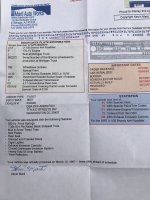Interesting that they specify a .5-3 deg angle for all the joints in a shaft. It's been a long time since I've had a stock height EB but I'm guessing the joint angles in a stock height truck double cardan exceed that?
Todd Z.
The TSB is crap. (I think I mentioned that above...) It is very generic, and it has minimal applicability to a double Cardan driveshaft in an early Bronco.
The vast majority of driveshaft applications do in fact run under 3 degrees per joint. This is usually accomplished by installing the engine downhill, and the rear pinion uphill. Most applications (at static ride height) run the crankshaft centerline directly co-linear with the rear pinion centerline. So all of the requirements of the TSB can be met. But the TSB does NOT tell you what do do when the physics exceed the constraints of the model.
You can tell that the TSB is intellectually bankrupt, because it advocates the use of larger components in the event that recommended angles are exceeded. This is not at all interesting from the perspective of harmonics. (which is the stated objective of the TSB.) Once again, the TSB is a generic Spicer Dana application engineering document used primarily to deflect warranty claims against the Tier 1.
You are absolutely correct that the 0.5 to 3 degree requirement is "not a requirement." My stone stock 67 U13 Military Bronco at static ride height runs the 6 cylinder engine at a 4 degree inclination. (de-clination if you prefer) The rear 9 inch pinion runs a 12 degree inclination. The front Dana 30 runs a 7 degree inclination. So the crankshaft points down 4 degrees toward the rear axle, the axle points up 12 degrees to meet the output yoke. The rear driveshaft front u-joint runs at an additional 8 degrees. So the rear axle exceeds the 3 degree engineering recommendation in the TSB by a little. But the Front driveshaft exceeds the 3 degrees by a LOT. The front output of the transfer case points UP 4 degrees. But the driveshaft points DOWN 7 degrees, resulting in an 11 degree total angle at the front driveshaft rear yoke. 11 is greater than 3. (This is why the front driveshaft CV binds first on lifted Broncos.)
I realize that I typed more than 5 words again...but I like Steve83, and don't want to argue. But I can't let my 2 Engineering Degrees and Six Sigma Black Belt go to waste. I'm off my soap box now.












